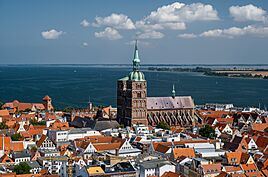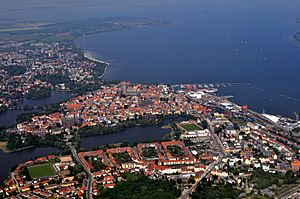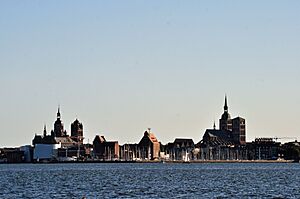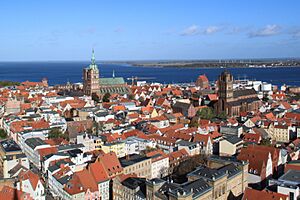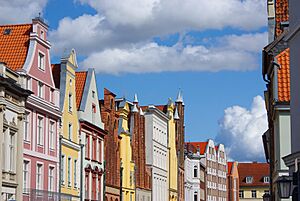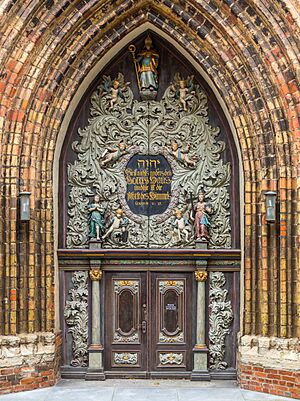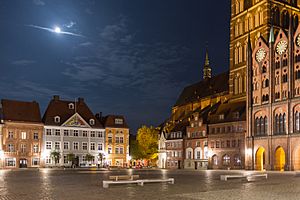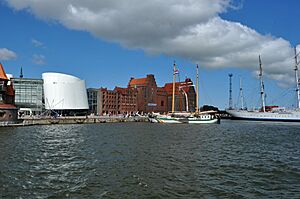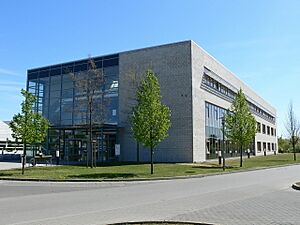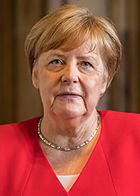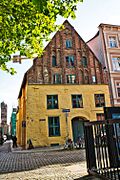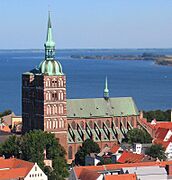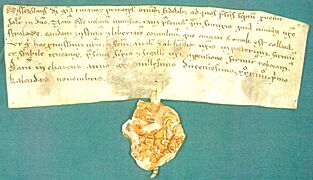Stralsund facts for kids
Quick facts for kids
Stralsund
|
|||
|---|---|---|---|
|
Stralsund with Strelasund in the background
St Mary's Church
St Nick
Rügenbrücke
St James' Church
|
|||
|
|||
| Country | Germany | ||
| State | Mecklenburg-Vorpommern | ||
| District | Vorpommern-Rügen | ||
| Founded | 1168 | ||
| Elevation | 13 m (43 ft) | ||
| Population
(2022-12-31)
|
|||
| • Total | 59,363 | ||
| Time zone | CET/CEST (UTC+1/+2) | ||
| Postal codes |
18435, 18437, 18439
|
||
| Dialling codes | 03831 | ||
| Vehicle registration | HST | ||
| Website | www.stralsund.de | ||
Stralsund is a cool city in northeastern Germany. It's officially called the Hanseatic City of Stralsund. This city is the fifth largest in the state of Mecklenburg-Western Pomerania.
Stralsund sits right on the southern coast of the Strelasund. This is a narrow body of water that separates the big island of Rügen from the mainland. Two bridges and several ferries connect Stralsund to Rügen. Rügen is actually the largest island in Germany!
The city was founded way back in 1234, making it the oldest city in the Pomerania region. It was once a very important member of the Hanseatic League, a powerful group of trading cities in the Middle Ages. Stralsund was also under Swedish rule for a long time, from 1628 until the early 1800s.
Today, Stralsund's old town is a UNESCO World Heritage Site. This means it's a super important historical place! It's famous for its amazing Brick Gothic buildings. These are old buildings made from red bricks. The city is also home to the German Oceanographic Museum, which has a huge aquarium called the Ozeaneum.
Stralsund's main jobs include shipbuilding, fishing, and mechanical engineering. More and more, people also work in tourism, life sciences, and high tech industries.
Contents
- Exploring Stralsund's Location
- What's in a Name? The Meaning of Stralsund
- A Look Back: Stralsund's History
- Cool Places to See: Culture and Sights
- Learning in Stralsund: Education
- Getting Around: Transport
- City Leadership: Governance
- Friends Around the World: Twin Towns
- Sports in Stralsund
- Famous People from Stralsund
- Images for kids
- See also
Exploring Stralsund's Location
Stralsund is in the Mecklenburg-Vorpommern state of Germany. It's part of the Western Pomerania region. The city is separated from Rügen island by the Strelasund. This water channel flows into the Baltic Sea.
Weather in Stralsund
Stralsund gets about 656 millimeters (25.8 inches) of rain each year. February is usually the driest month, and July is the wettest. The weather doesn't change too much throughout the year.
| Climate data for Stralsund, elevation: 13 m, 1991–2021 normals | |||||||||||||
|---|---|---|---|---|---|---|---|---|---|---|---|---|---|
| Month | Jan | Feb | Mar | Apr | May | Jun | Jul | Aug | Sep | Oct | Nov | Dec | Year |
| Mean daily maximum °C (°F) | 2.9 (37.2) |
3.7 (38.7) |
6.9 (44.4) |
12.0 (53.6) |
16.6 (61.9) |
19.8 (67.6) |
22.2 (72.0) |
21.8 (71.2) |
18.1 (64.6) |
12.9 (55.2) |
7.8 (46.0) |
4.4 (39.9) |
12.4 (54.4) |
| Daily mean °C (°F) | 1.1 (34.0) |
1.4 (34.5) |
3.8 (38.8) |
8.1 (46.6) |
12.8 (55.0) |
16.2 (61.2) |
18.7 (65.7) |
18.3 (64.9) |
14.9 (58.8) |
10.3 (50.5) |
5.9 (42.6) |
2.7 (36.9) |
9.5 (49.1) |
| Mean daily minimum °C (°F) | −0.9 (30.4) |
−0.8 (30.6) |
0.7 (33.3) |
4.2 (39.6) |
8.6 (47.5) |
12.2 (54.0) |
14.9 (58.8) |
14.7 (58.5) |
11.8 (53.2) |
7.8 (46.0) |
3.9 (39.0) |
0.9 (33.6) |
6.5 (43.7) |
| Average precipitation mm (inches) | 54.0 (2.13) |
45.0 (1.77) |
50.0 (1.97) |
48.0 (1.89) |
62.0 (2.44) |
77.0 (3.03) |
84.0 (3.31) |
82.0 (3.23) |
61.0 (2.40) |
56.0 (2.20) |
52.0 (2.05) |
55.0 (2.17) |
726 (28.59) |
| Average precipitation days | 9 | 8 | 8 | 8 | 9 | 9 | 10 | 10 | 8 | 8 | 9 | 9 | 105 |
| Mean monthly sunshine hours | 83.7 | 103.6 | 164.3 | 261.0 | 313.3 | 318.0 | 331.7 | 303.8 | 219.0 | 155.0 | 90.0 | 71.3 | 2,414.7 |
| Source: Climate-Data.org | |||||||||||||
Natural Landscape and Features
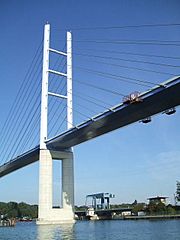
Stralsund is on the Strelasund, a strait of the Baltic Sea. Because it's so close to Rügen island, people call Stralsund the "Gateway to the Island of Rügen." The Strelasund Crossing is the only fixed link to the mainland.
The city also has its own forest and three ponds: the Knieperteich, Frankenteich, and Moorteich. These ponds and the Strelasund make the Old Town feel like a protected island. Stralsund is also near the Western Pomerania Lagoon Area National Park, a beautiful natural area.
City Areas
Stralsund covers about 54 square kilometers (20.8 square miles). It has almost 58,000 people living there. The city is divided into different areas, like the Old Town, Knieper, Tribseer, and Franken.
Nearby Towns and Cities
Larger cities close to Stralsund include Greifswald and Rostock. Smaller towns nearby are Barth and Ribnitz-Damgarten. Many small villages around Stralsund have grown a lot since 1990. This is because people who work in Stralsund often live in these nearby villages.
What's in a Name? The Meaning of Stralsund
The name "Stralsund" comes from an old language called Polabian. In Polabian, "Strale" or "Stralow" means "arrow." The city's name combines this "arrow" with the Germanic word "sund," which means a strait or sound (a narrow channel of water).
The city's coat of arms even shows a silver cross above a silver arrow. This design reminds everyone of the city's name and its past as a Hanseatic trading city.
A Look Back: Stralsund's History
Who ruled here?
Principality of Rügen 1168–1325
![]() Duchy of Pomerania 1325–1648
Duchy of Pomerania 1325–1648
![]() Sweden 1648–1807
Sweden 1648–1807
![]() French Empire 1807–1809
French Empire 1807–1809
![]() Prussian rebels 1809
Prussian rebels 1809
![]() French Empire 1809–1810
French Empire 1809–1810
![]() Sweden 1810–1812
Sweden 1810–1812
![]() French Empire 1812–1813
French Empire 1812–1813
![]() Sweden 1813–1814
Sweden 1813–1814
![]() Denmark, 1814–1815
Denmark, 1814–1815
![]() Kingdom of Prussia, 1815–1918
Kingdom of Prussia, 1815–1918
![]() German Reich, 1918–1945
German Reich, 1918–1945
![]() Soviet occupation zone 1945–1949
Soviet occupation zone 1945–1949
![]() German Democratic Republic 1949–1990
German Democratic Republic 1949–1990
![]() Federal Republic of Germany 1990–present
Federal Republic of Germany 1990–present
Long ago, the area around Stralsund was part of the Principality of Rügen. This region was ruled by West Slavic people. In 1168, it became part of the Kingdom of Denmark.
Many German settlers and merchants moved to the area. In 1234, Prince Wizlaw I of Rügen officially made "Stralow" a town. He gave it special laws, and it grew quickly.
The city's success made the powerful city of Lübeck jealous. Lübeck burned Stralsund down in 1249. But Stralsund was rebuilt with strong walls, 11 gates, and 30 watchtowers!
In 1293, Stralsund joined the Hanseatic League. This was a group of powerful trading cities. In the 14th century, about 300 ships from Stralsund sailed the Baltic Sea.
During the Thirty Years' War in 1628, the city was attacked. But Stralsund fought back with help from Denmark and Sweden. After the war, Stralsund became part of Swedish Pomerania in 1648. It stayed under Swedish control until 1815, when it became part of Prussia.
In World War II, Stralsund was bombed by Allied forces. Many buildings were destroyed. After the war, it became part of East Germany. During this time, many new apartment buildings were built. The city's shipyard mainly built ships for the Soviet Union.
After Germany reunited in 1990, the historic old town was beautifully restored. In 2002, Stralsund's old town, along with Wismar's old town, became a UNESCO World Heritage Site.
Cool Places to See: Culture and Sights
| UNESCO World Heritage Site | |
|---|---|
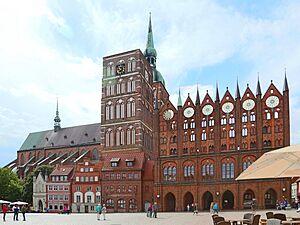
Stralsund: Alter Markt Square with the city hall and the St. Nicholas Church
|
|
| Part of | Historic Centres of Stralsund and Wismar |
| Criteria | Cultural: ii, iv |
| Inscription | 2002 (26th Session) |
| Area | 80 ha |
| Buffer zone | 340 ha |
Stralsund's historic old town is a UNESCO World Heritage Site. It has many amazing buildings from the Hanseatic period. You can see Brick Gothic, Renaissance, and Baroque styles.
Main Attractions in Stralsund
- The Alter Markt (Old Market) Square is the heart of the old town. Here you'll find the Gothic city hall, built between 1270 and 1360.
- Behind the city hall is the huge St. Nicholas' Church. The square also has old houses like the Gothic Wulflamhaus from the 14th century.
- Saint Mary's Church is the biggest church in Stralsund. It was built between 1383 and 1473. From 1625 to 1647, it was the tallest building in the world! You can climb its 104-meter-high tower for amazing views of Stralsund and the islands of Rügen and Hiddensee.
- St. John's Abbey, a Franciscan monastery from 1254, is one of the city's oldest buildings.
- The old German Navy training ship, "Gorch Fock" 1, is now a floating museum in the harbor.
- The Monastery of Saint Catherine, built in the 15th century, now holds two museums. One is Stralsund's Museum of Cultural History. The other is the German Oceanographic Museum, which is Germany's largest aquarium.
- Besides the German Oceanographic Museum, Stralsund has the popular Ozeaneum. It was named European Museum of the Year in 2010! There's also the Nautineum on Dänholm island, which is a nautical center.
Historic Buildings and Monuments
- Old Town (Altstadt)
The center of Stralsund is full of historic buildings. Since 1990, many parts of the old town have been restored. Over 500 of the city's 800 listed buildings are in the Old Town. Because of its history and architecture, Stralsund's old town is a UNESCO World Cultural Heritage site.
- Alter Markt Square
The Brick Gothic city hall from 1278 is a main landmark on the Alter Markt Square. It has a fancy "show façade" that was built to show off the city's wealth. You can walk through the city hall and see its huge Gothic cellar vaults.
- Old Town Houses
The old houses with their unique gables make the Old Town streets special. Many have been carefully restored. The Museum of Cultural History is in one of the oldest surviving Hanseatic houses. It helps you understand the city's history over seven centuries.
- Churches
Three big medieval Brick Gothic churches show how important Stralsund was long ago. These are St. Mary's Church, St. Nicholas Church, and St. James Church. St. Mary's tower offers amazing views of the city and Rügen island.
- Monasteries
St. John's Abbey, a Franciscan monastery from 1254, now holds the Stralsund City Archives. It also hosts cultural events like outdoor plays. The Heilgeistkloster, first mentioned in 1256, is now the Hospital of the Holy Spirit.
- The Port
Ferries to Hiddensee and Altefähr leave from Stralsund's port. You can also take boat tours of the harbor. In summer, many yachts and boats dock here. The old warehouses and the city's skyline create a beautiful view. The old sailing ship, Gorch Fock, is another popular sight at the harbor.
Learning in Stralsund: Education
The Fachhochschule Stralsund is a University of Applied Sciences. It has a modern campus north of the old town, right by the Strelasund. About 2,500 students attend this university. It's known as one of the best public universities in Germany for subjects like economics. It also offers international study programs.
Getting Around: Transport
Stralsund is connected to the A20 motorway, which goes towards Berlin and Hamburg. Other main roads connect to Rostock and Rügen.
The Stralsund Hauptbahnhof (main train station) has train lines to Berlin, Rostock, and other cities.
If you travel by air, you usually fly into Rostock–Laage Airport. There's also a smaller local airport called Stralsund Barth Airport. City buses are run by SWS (Stadtwerke Stralsund).
City Leadership: Governance
The current mayor of Stralsund is Alexander Badrow. He has been the mayor since 2008. The city also has a city council that helps make decisions for Stralsund.
Friends Around the World: Twin Towns
Stralsund has "twin towns" or "sister cities" in different countries. This means they have special friendly relationships.
Sports in Stralsund
Football Fun
FC Pommern Stralsund was a local football team. It existed from 1994 to 2018.
Motorcycle Speedway
The Paul Greifzu Stadium was built in 1957. It's home to the MC Nordstern Stralsund e.V. speedway team. This team won the German Team Speedway Championship in 2015 and 2022.
Famous People from Stralsund
Many interesting people have come from Stralsund!
- Carl Wilhelm Scheele (1742–1786) was a Swedish-German chemist who discovered many chemical elements.
- Hermann Burmeister (1807–1892) was a German-Argentine zoologist and botanist.
- Angela Merkel (born 1954) is a very famous politician who served as the Chancellor of Germany. Her office is still in Stralsund!
- Carsten Embach (born 1968) is a bobsledder who won a gold medal at the 2002 Winter Olympics.
Images for kids
See also
 In Spanish: Stralsund para niños
In Spanish: Stralsund para niños
- Stralsunder Highflier


